Study of the Effects of Aging Treatment on Astroloy Processed via Hot Isostatic Pressing
Abstract
1. Introduction
2. Materials and Methods
2.1. Sample Pre-Treatment
2.2. First and Second Ageing
2.3. Observation of the Microstructure
3. Results
3.1. Differential Scanning Calorimetry (DSC) Results
3.2. First Ageing γ′ Assessment
- : these are irregular-shaped particles, always located at the γ grain boundaries. They have an elongated shape and, as a consequence, they were treated in terms of equivalent ellipses. The principal axis is typically 1.5 µm long and the aspect ratio is ca. 7. accounts for the 24% of the total detected γ′;
- : these particles are typically constituted by an array of sharp cuboidal precipitates arranged along preferential directions randomly dispersed in the austenitic grains. has a representative size of ca. 606 nm and accounts almost for the 30% of the total γ′;
- : these particles are uniformly dispersed throughout the matrix, in the interspace among coarser precipitates. has an average size of 230 nm and constitutes the largest part of the total γ′ fraction, i.e., 40%.
- Ultra-fine : this type of particles accounts for the 6% of the total γ′ and it has an average size of about 50 nm. It is mainly located around the coarsest precipitates.
- results much thinner if compared to the former case. Aspect ratio can be as high as 12 with the major axis that ranges between 0.8 and 1.3 µm. It accounts for less than the 2% of the total γ′ vol fraction.
- has an average size of 310 nm and accounts for the 73% of the total γ′
- shows an average size of 213 nm and represent the 25% of the total γ′
3.3. Second Ageing γ′ Assessment
- : The principal axis still ranges between 1.5 and 1.6 µm in terms of length and the aspect ratio didn’t change with respect to first aging conditions. accounts for the 23% of the total γ′ detected;
- has an average size of ca. 628 nm, and accounts for ca. the 23% of the total γ′;
- has an average size of ca. 237 nm and constitutes the 51% of the total γ′.
- Ultra-fine : this type of particles represents the 3% of the total γ′ with an average size of 70 nm.
- exhibits an aspect ratio of 12 with the major axis ranging between 0.8 and 1.4 µm. It accounts for the 1.5% of the total γ′.
- has an average size of 323 nm and accounts for the 62% of the total γ′
- shows an average size of 233 nm and accounts for the 36.5% of the total γ′
- No trace of ultra-fine was detected.
3.4. Grain Coarsening
3.5. Carbides Assessment
3.6. X-ray Diffraction (XRD) Analysis
4. Discussion
4.1. γ′ Reinforcing System
4.2. M6C and M23C6 Carbides
5. Conclusions
- LT and HT samples benefit most from the first aging. The second aging only slightly improves material hardness. This can be explained with the fact that only minor microstructural changes occur during this treatment step. Peak hardness is achieved after first aging performed at 760 °C for 8 h.
- LT samples achieved a greater hardness increase after first and second aging mainly due to the intense precipitation of finer γ′ i.e., . Furthermore, a “ultra-fine” was also revealed after first ageing.
- and coarsening occurs during the first and second ageing. This behavior was accurately described through a theoretical treatment evidencing that always grows faster than . Furthermore this treatment allowed to clearly demonstrate that HT samples are more prone to coarsening.
- M6C, molybdenum carbides, form directly during HIPping and can only be partially solutioned during the HT solutioning, while they remain unaltered during the LT one. M23C6 appears only in HT sample and after second aging. In this state, they form very thin films at grain boundaries which could cause material embrittlement.
- According to the small increase in material properties and the risk of film carbides formation at grain boundaries, leads to suggestion not to perform the second aging on HIP consolidated Astroloy, in particular, if high-temperature solutioning is applied. The suppression of the second aging step is also very attractive from a practical and industrial point of view as it can result in marked savings both in terms of processing time and cost.
Author Contributions
Funding
Conflicts of Interest
References
- Raisson, G.; Guédou, J.; Guichard, D.; Rongvaux, J. Production of net-shape static parts by direct HIPing of nickel base superalloy prealloyed powders. Adv. Mater. Res. 2011, 278, 277–282. [Google Scholar] [CrossRef]
- Chang, D.R.; Krueger, D.D.; Sprague, R.A. Superalloy Powder Processing, Properties, and Turbine Disk Applications. In Superalloys 1984, Proceedings of the Fifth International Symposium on Superalloys, Champion, PA, USA, 7–11 October 1984; Seven Springs Mountain Resort: Champion, PA, USA, 1984; pp. 245–273. [Google Scholar]
- Buckingham, R.C.; Argyrakis, C.; Hardy, M.C.; Birosca, S. The effect of strain distribution on microstructural developments during forging in a newly developed nickel base superalloy. Mater. Sci. Eng. A 2016, 654, 317–328. [Google Scholar] [CrossRef]
- Ning, Y.; Fu, M.W.; Yao, W. Recrystallization of the hot isostatic pressed nickel-base superalloy FGH4096. II: Characterization and application. Mater. Sci. Eng. A 2012, 539, 101–106. [Google Scholar] [CrossRef]
- Qiu, C.; Wu, X.; Mei, J.; Andrews, P.; Voice, W. Influence of heat treatment on microstructure and tensile behavior of a hot isostatically pressed nickel-based superalloy. J. Alloys Compd. 2013, 578, 454–464. [Google Scholar] [CrossRef]
- Qiu, C.L.; Attallah, M.M.; Wu, X.H.; Andrews, P. Influence of hot isostatic pressing temperature on microstructure and tensile properties of a nickel-based superalloy powder. Mater. Sci. Eng. A 2013, 564, 176–185. [Google Scholar] [CrossRef]
- Rao, G.A.; Kumar, M.; Sarma, D.S. Effect of standard heat treatment on the microstructure and mechanical properties of hot isostatically pressed superalloy inconel. Mater. Sci. Eng. A 2003, 355, 114–125. [Google Scholar] [CrossRef]
- Bassini, E.; Marchese, G.; Cattano, G.; Lombardi, M.; Biamino, S.; Ugues, D.; Vallillo, G.; Picqué, B. Influence of solutioning on microstructure and hardness of hot isostatically pressed Astroloy. J. Alloys Compd. 2017, 723. [Google Scholar] [CrossRef]
- Bassini, E.; Vola, V.; Lorusso, M.; Ghisleni, R.; Lombardi, M.; Biamino, S.; Ugues, D.; Vallillo, G.; Picqué, B. Net shape HIPping of Ni-superalloy: Study of the interface between the capsule and the alloy. Mater. Sci. Eng. A 2017, 695. [Google Scholar] [CrossRef]
- Kissinger, R.D.; Nair, S.V.; Tien, J.K. Influence of Powder Particle Size Distribution and Pressure on the Kinetics of Hot Isostatic Pressing (HIP) Consolidation of P/M Supperalloy Rene 95. In Superalloys 1984, Proceedings of the Fifth International Symposium on Superalloys, Champion, PA, USA, 7–11 October 1984; Seven Springs Mountain Resort: Champion, PA, USA; pp. 285–294.
- Ingesten, N.G.; Warren, R.; Winberg, L. The Nature and Origin of Previous Particle Boundary Precipitates in P/M Superalloys. In High Temperature Alloys for Gas Turbines; MCB UP Ltd.: Bingley, UK, 1982; pp. 1013–1014. [Google Scholar]
- Dahlen, M.; Ingesten, N.G.; Fishchmeister, H. Parameters influencing particle boundary precipitation in superalloy powders. Mod. Dev. Powder Metall. 1981, 14, 3–14. [Google Scholar]
- Williams, D.L. Hot isostatically pressed Alloy APK1, a nickel-base superalloy. Powder Metall. 1977, 2, 84–89. [Google Scholar] [CrossRef]
- Maurer, G.; Castledine, W.; Schweizer, F.; Mancuso, S. Development of HIP consolidated P/M superalloys for conventional forging to gas turbine engine components. In Superalloys; The Minerals, Metals & Materials Society: Pittsburgh, PA, USA, 1996; pp. 645–652. [Google Scholar]
- Furrer, D.; Fecht, H. Ni-based superalloys for turbine discs. J. Met. 1999, 51, 14–17. [Google Scholar] [CrossRef]
- Radavich, J.; Furrer, D. Assessment of Russian P/M Superalloy EP741NP. In Superalloys 2004 TMS; The Minerals, Metals & Materials Society: Pittsburgh, PA, USA, 2004; pp. 381–390. [Google Scholar]
- Baccino, R.; Moret, F.; Pellerin, F.; Guichard, D.; Raisson, G. High performance and high complexity net shape parts for gas turbines: The ISOPREC® powder metallurgy process. Mater. Des. 2000, 21, 345–350. [Google Scholar] [CrossRef]
- Bassini, E.; Iannucci, L.; Lombardi, M.; Biamino, S.; Ugues, D.; Vallillo, G.; Picqué, B. Net shape HIPping of a Ni-superalloy: A study of the influence of an as-leached surface on mechanical properties. J. Mater. Process. Technol. 2019, 271, 476–487. [Google Scholar] [CrossRef]
- Yang, W.; Mao, J.; Wang, W.; Zou, J.; Zhou, R. Effects of heat treatment on prior particle boundary precipitation in a powder metallurgy nickel base superalloy. Adv. Perform. Mater. 1995, 2, 269–279. [Google Scholar] [CrossRef]
- Waters, R.E.; Lea, C. Prior particle boundaries in hot isostatically pressed by Auger electron spectroscopy. Met. Technol. 1981, 8, 194–200. [Google Scholar] [CrossRef]
- Roncery, L.M.; Ruttert, B.; Huth, S.; Theisen, W. In fl uence of temperature, pressure and cooling rate during hot isostatic pressing on the microstructure of an SX Ni-base superalloy. Mater. Des. 2016, 97, 544–552. [Google Scholar] [CrossRef]
- Fu, B.D.; Du, K.; Han, G.M.; Cui, C.Y.; Zhang, J.X. Deformation mechanisms in a Co-rich nickel based superalloy with different size of γ′ precipitates. Mater. Lett. 2015, 152, 272–275. [Google Scholar] [CrossRef]
- Zhang, M.; Li, F.; Yuan, Z.; Li, J.; Wang, S. Effect of heat treatment on the micro-indentation behavior of powder metallurgy nickel based superalloy FGH96. Mater. Des. 2013, 49, 705–715. [Google Scholar] [CrossRef]
- Whitmore, L.; Ahmadi, M.R.; Guetaz, L.; Leitner, H.; Povoden-Karadeniz, E.; Stockinger, M.; Kozeschnik, E. The microstructure of heat-treated nickel-based superalloy 718Plus. Mater. Sci. Eng. A 2014, 610, 39–45. [Google Scholar] [CrossRef]
- Wang, S.; Wang, L.; Liu, Y.; Xu, G.; Zhang, B.; Zhao, G. Effect of long-term aging on the fatigue crack growth rate of a nickel-based superalloy. Mater. Sci. Eng. A 2011, 528, 2110–2117. [Google Scholar] [CrossRef]
- Maciejewski, K.; Ghonem, H. Isotropic and kinematic hardening as functions of gamma prime precipitates in a nickel-based superalloy. Int. J. Fatigue 2014, 68, 123–135. [Google Scholar] [CrossRef]
- Wang, X.; Zhou, Y.; Zhao, Z.; Zhang, Z. The γ′ precipitate rafting and element distribution during hot isostatic pressing in a nickel-based superalloy. Mater. Des. 2015, 86, 836–840. [Google Scholar] [CrossRef]
- Galindo-Nava, E.I.; Connor, L.D.; Rae, C.M.F. On the prediction of the yield stress of unimodal and multimodal γ′ Nickel-base superalloys. Acta Mater. 2015, 98, 377–390. [Google Scholar] [CrossRef]
- Furrer, D.U.; Shankar, R.; White, C. Optimizing the heat treatment of Ni-based superalloy turbine discs. JOM 2003, 55, 32–34. [Google Scholar] [CrossRef]
- Balakrishna Bhat, T.; Arunachalam, V.S. Strengthening mechanisms in alloys. Proc. Indian Acad. Sci. Sect. C Eng. Sci. 1980, 3, 275–296. [Google Scholar] [CrossRef]
- Dong, X.; Zhang, X.; Du, K.; Zhou, Y.; Jin, T.; Ye, H. Microstructure of Carbides at Grain Boundaries in Nickel Based Superalloys. J. Mater. Sci. Technol. 2012, 28, 1031–1038. [Google Scholar] [CrossRef]
- Zhang, L.; Liu, H.; He, X.; Qu, X.; Qin, M.; Li, Z.; Zhang, G. Thermal evolution behavior of carbides and γ′ precipitates in FGH96 superalloy powder. Mater. Charact. 2012, 67, 52–64. [Google Scholar] [CrossRef]
- Collins, H.E. Relative Stability of Carbide and Intermetallic Phases in Nickel-Base Superalloys. Trans. ASM 1969, 62, 171–198. [Google Scholar] [CrossRef]
- Qin, X.Z.; Guo, J.T.; Yuan, C.; Hou, J.S.; Ye, H.Q. Precipitation and thermal instability of M23C6 carbide in cast Ni-base superalloy K452. Mater. Lett. 2008, 62, 258–261. [Google Scholar] [CrossRef]
- Lvov, G.; Levit, V.I.; Kaufman, M.J. Mechanism of primary MC carbide decomposition in Ni-base superalloys. Metall. Mater. Trans. A 2004, 35, 1669–1679. [Google Scholar] [CrossRef]
- Zhang, J.; Hu, R.; Wang, J.; Li, J. Secondary M6C Precipitation in Ni-20Cr-18W-1Mo Superalloy. J. Innov. Technol. Explor. Eng. 2013, 3, 48–51. [Google Scholar]
- Jiang, L.; Hu, R.; Kou, H.; Li, J.; Bai, G.; Fu, H. The effect of M 23C 6 carbides on the formation of grain boundary serrations in a wrought Ni-based superalloy. Mater. Sci. Eng. A 2012, 536, 37–44. [Google Scholar] [CrossRef]
- Hu, R.; Bai, G.; Li, J.; Zhang, J.; Zhang, T.; Fu, H. Precipitation behavior of grain boundary M23C6 and its effect on tensile properties of Ni–Cr–W based superalloy. Mater. Sci. Eng. A 2012, 548, 83–88. [Google Scholar] [CrossRef]
- Larson, J.M. Carbide morphology in p/m IN-792. Metall. Trans. A 1976, 7, 1497–1502. [Google Scholar] [CrossRef]
- Gessinger, G.H. Powder Metallurgy of Superalloys; Butterworth & Co.: Oxford, UK, 1984. [Google Scholar]
- Gayda, J.; Miner, R.V. The effect of microstructure on 650°C fatigue crack growth in P/M astroloy. Metall. Trans. A 1983, 14, 2301–2308. [Google Scholar] [CrossRef]
- Brunetaud, R.; Coutsouradis, D.; Gibbons, T.B.; Lindblom, Y.; Meadowcroft, D.B.; Stickler, R. High Temperature Alloys for Gas Turbines; MCB UP Ltd.: Bingley, UK, 1982. [Google Scholar]
- Zangeneh, S.; Lashgari, H.R.; Asnavandi, M. The effect of long-term service exposure on the stability of carbides in Co–Cr–Ni–W (X-45) superalloy. Eng. Fail. Anal. 2018, 84, 276–286. [Google Scholar] [CrossRef]
- Ardell, A.J. The effect of volume fraction on particle coarsening: Theoretical considerations. Acta Metall. 1972, 20, 61–71. [Google Scholar] [CrossRef]
- Davies, C.K.L.; Nash, P.; Stevens, R.N. The effect of volume fraction of precipitate on ostwald ripening. Acta Metall. 1980, 28, 179–189. [Google Scholar] [CrossRef]
- McLean, D. Predicting Growth of g’ in Nickel Alloys. Met. Sci. 1984, 18, 249–256. [Google Scholar] [CrossRef]
- Footner, P.K.; Richards, B.P. Long-term growth of superalloy y’ particles. J. Mater. Sci. 1982, 17, 2141–2153. [Google Scholar] [CrossRef]
- Kim, H.T.; Chun, S.S.; Yao, X.X.; Fang, Y.; Choi, J. Gamma prime (γ′) precipitating and ageing behaviours in two newly developed nickel-base superalloys. J. Mater. Sci. 1997, 32, 4917–4923. [Google Scholar] [CrossRef]
- Rao, G.A.; Srinivas, M.; Sarma, D.S. Effect of oxygen content of powder on microstructure and mechanical properties of hot isostatically pressed superalloy Inconel 718. Mater. Sci. Eng. A 2006, 435, 84–99. [Google Scholar] [CrossRef]
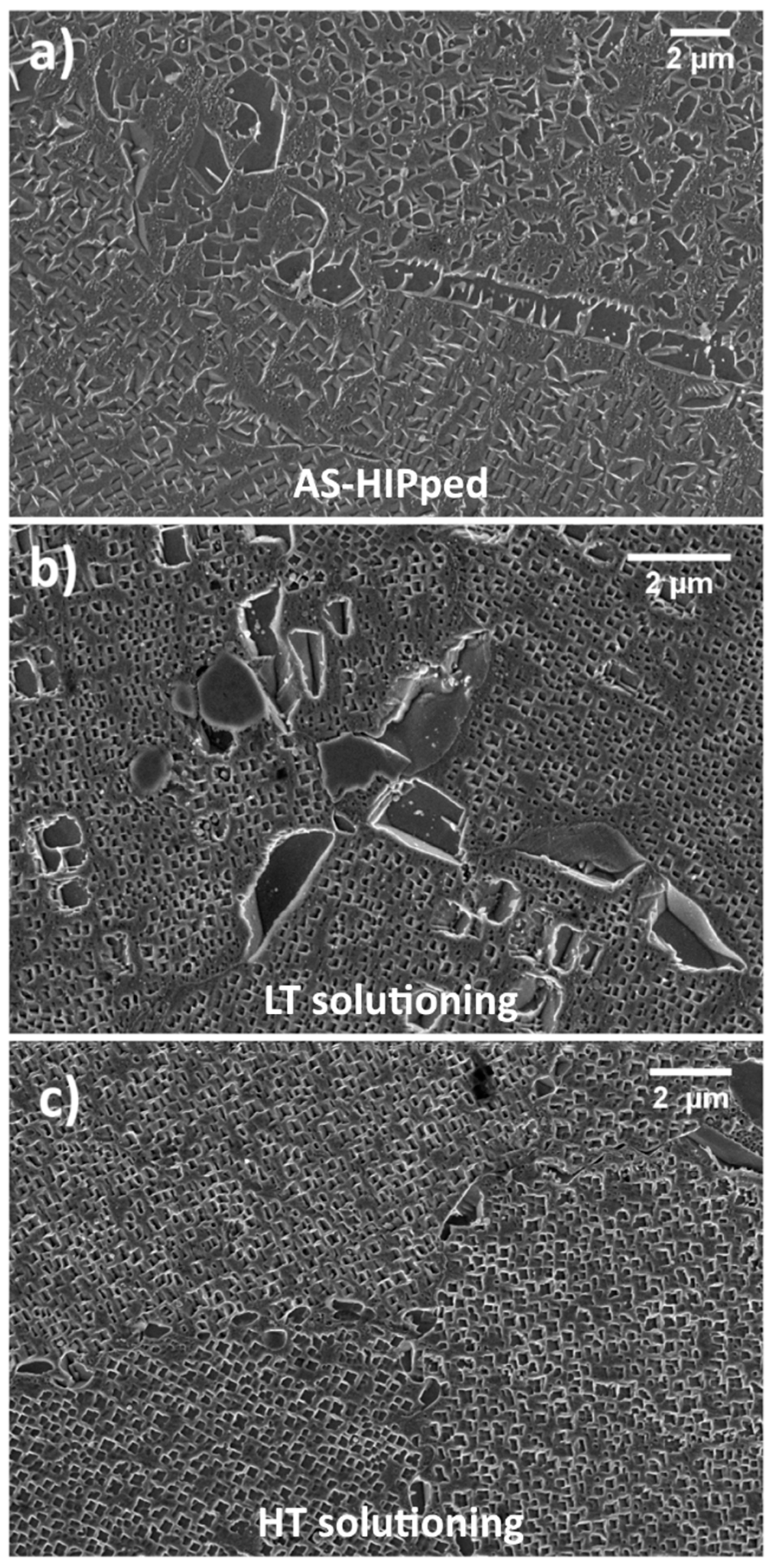
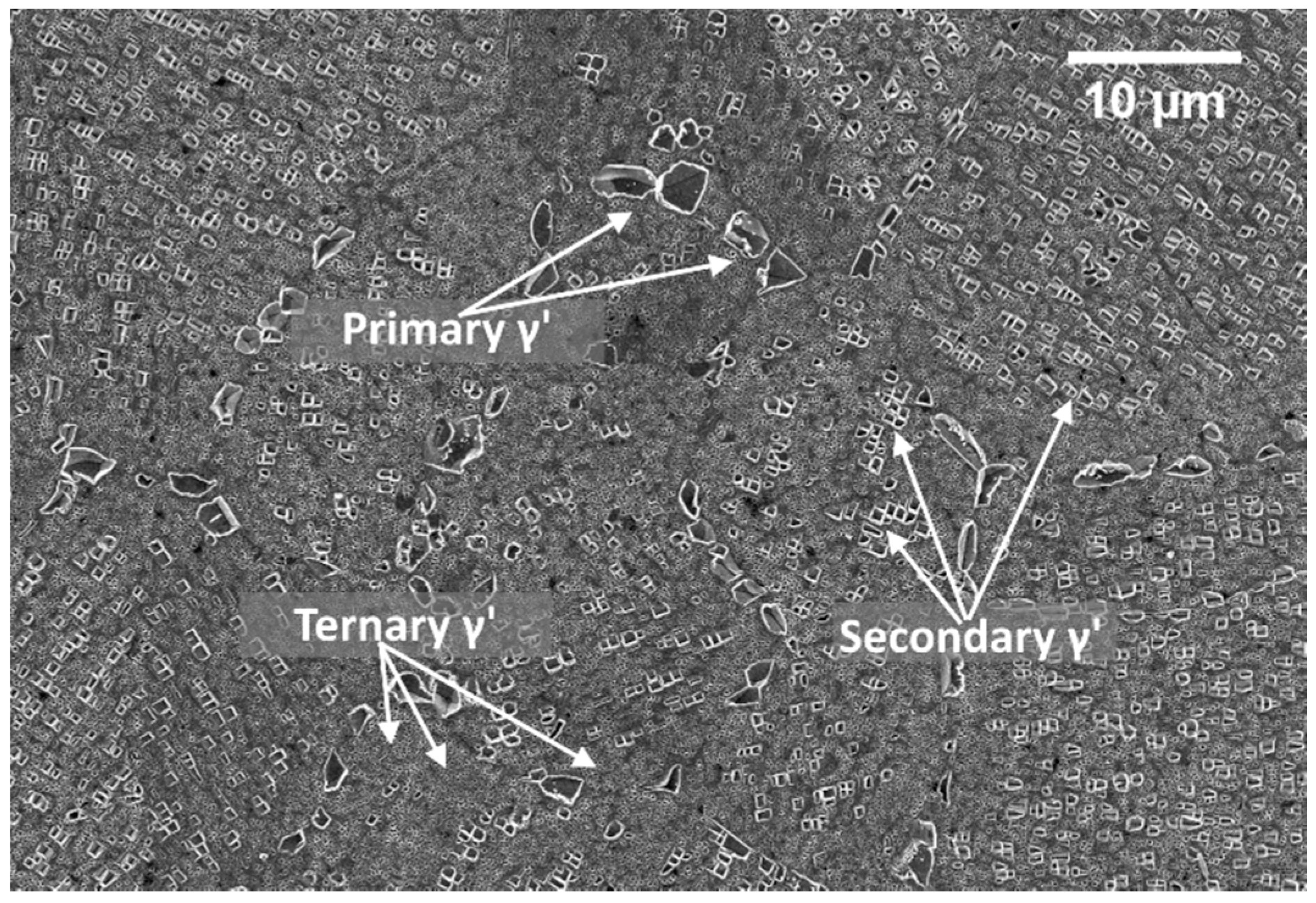
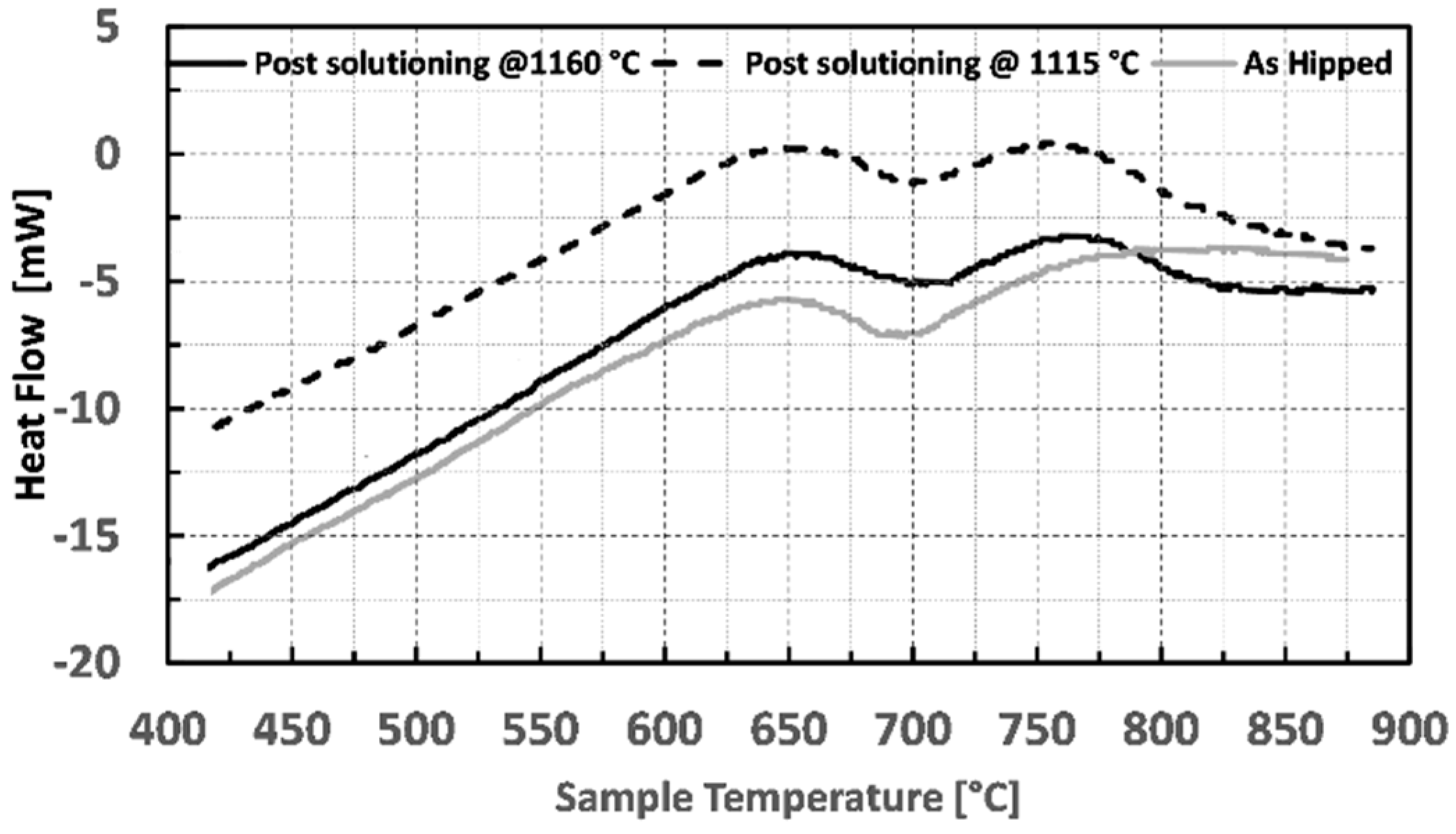

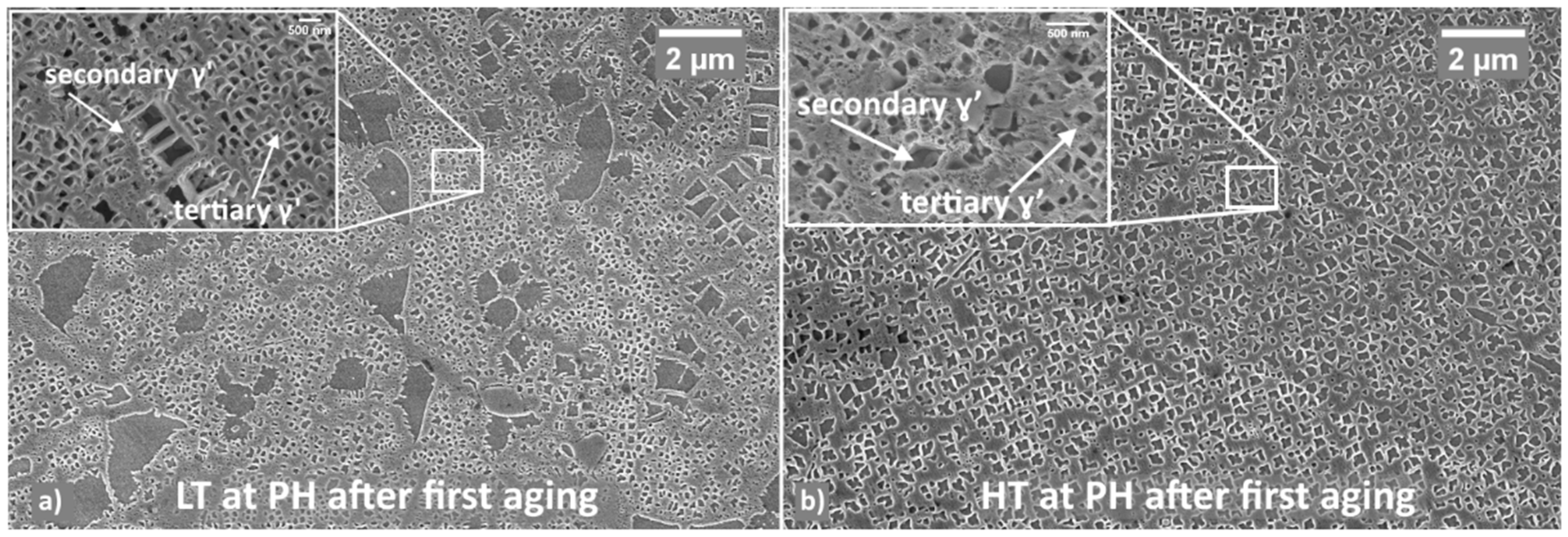


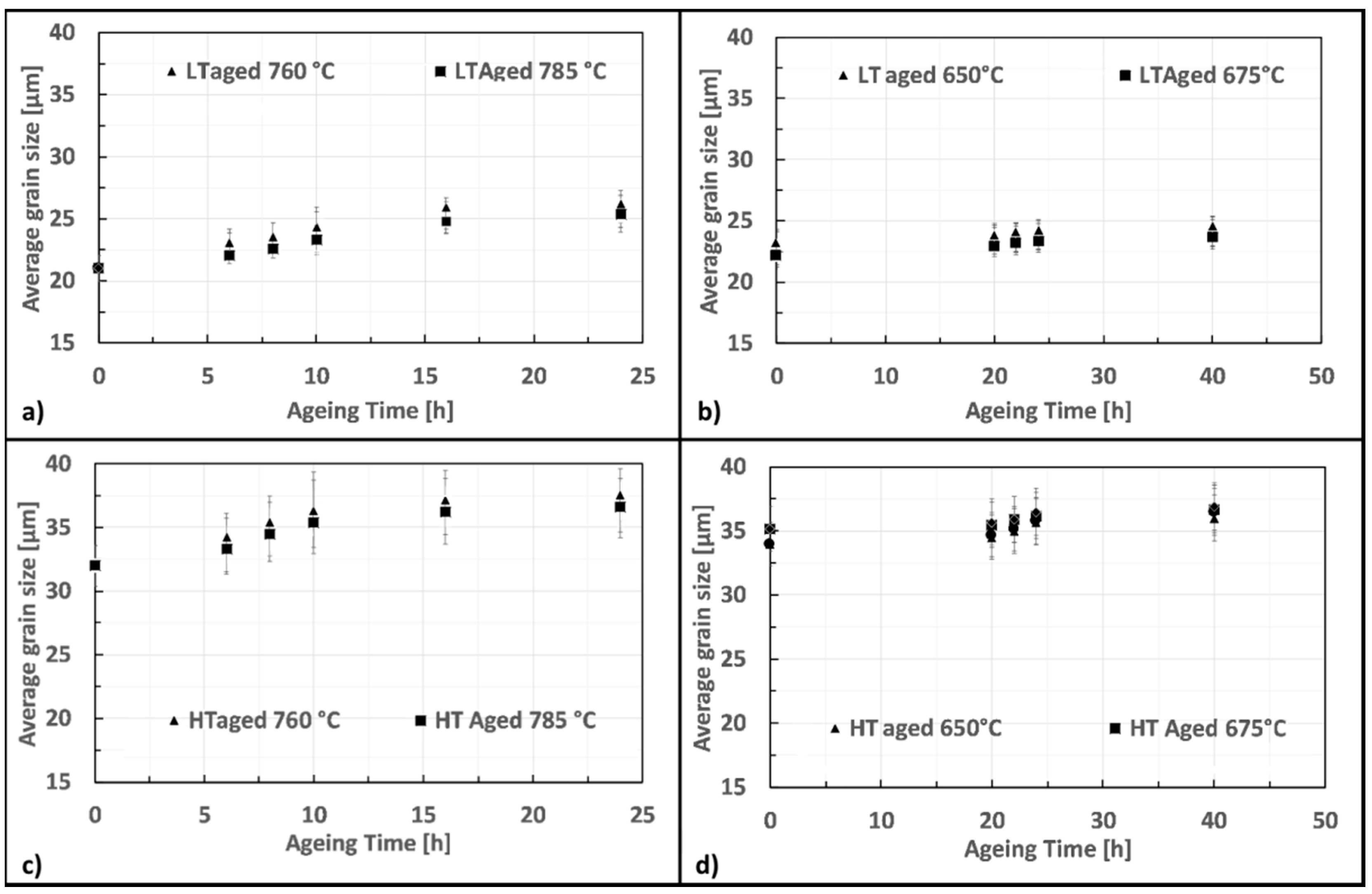
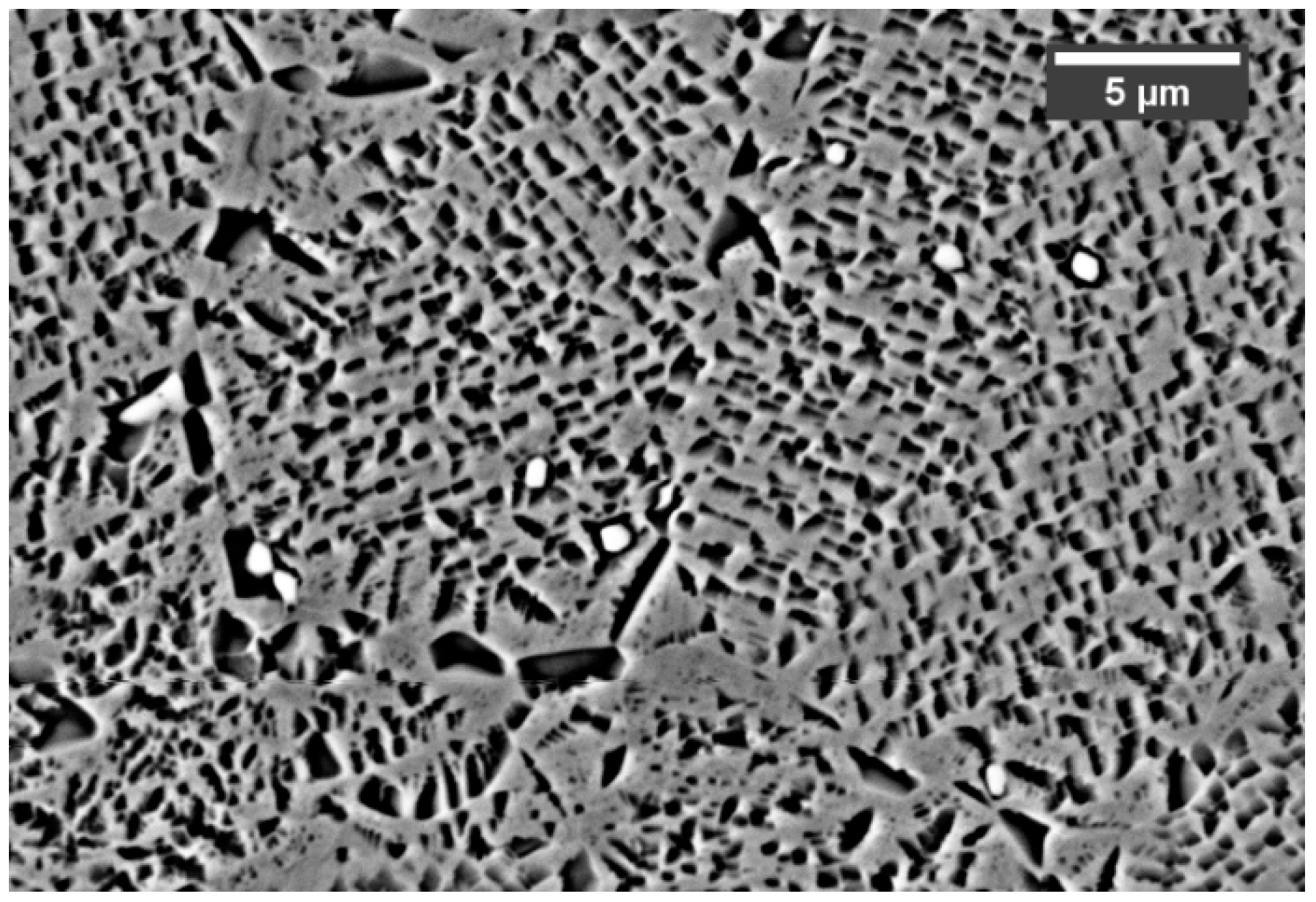



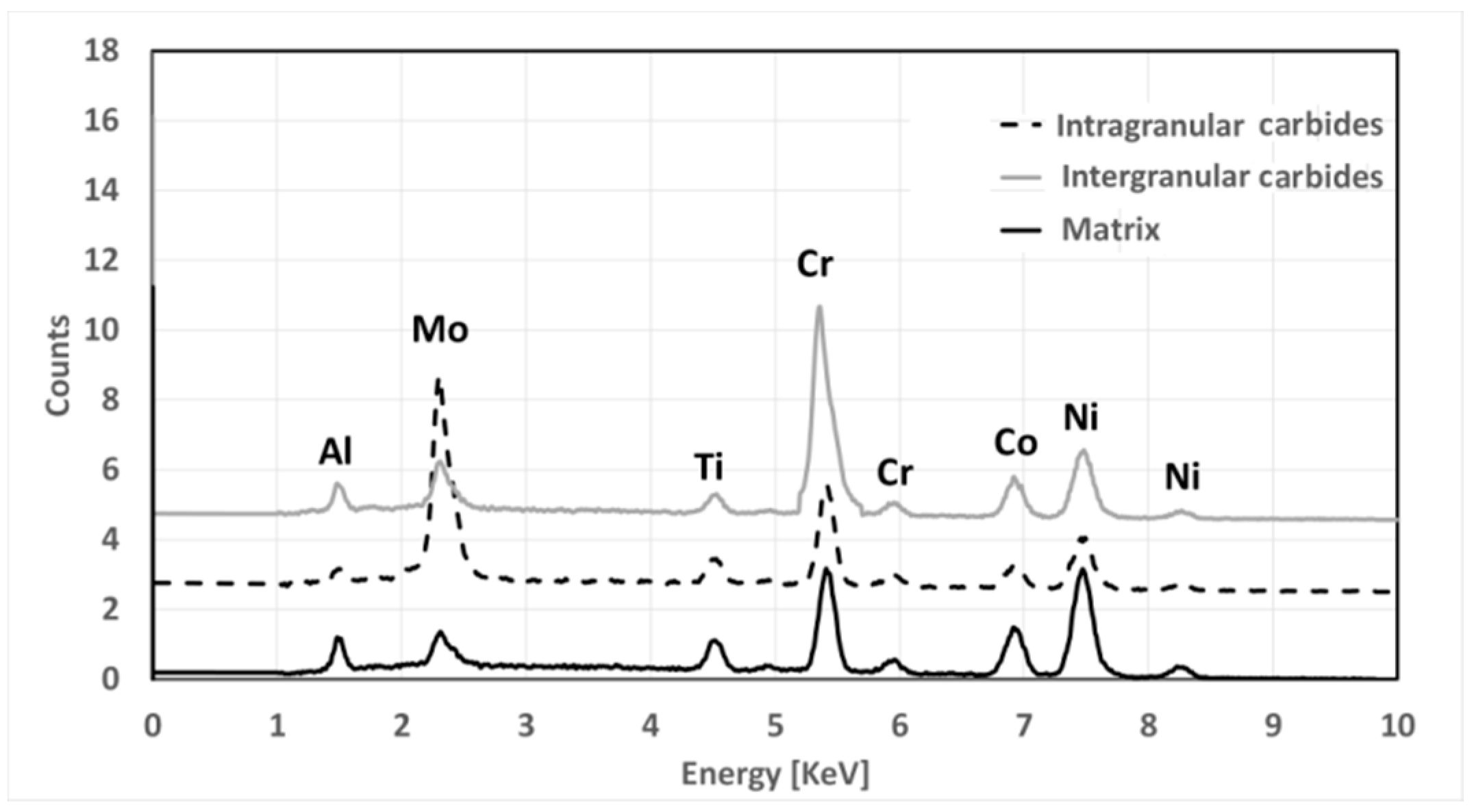

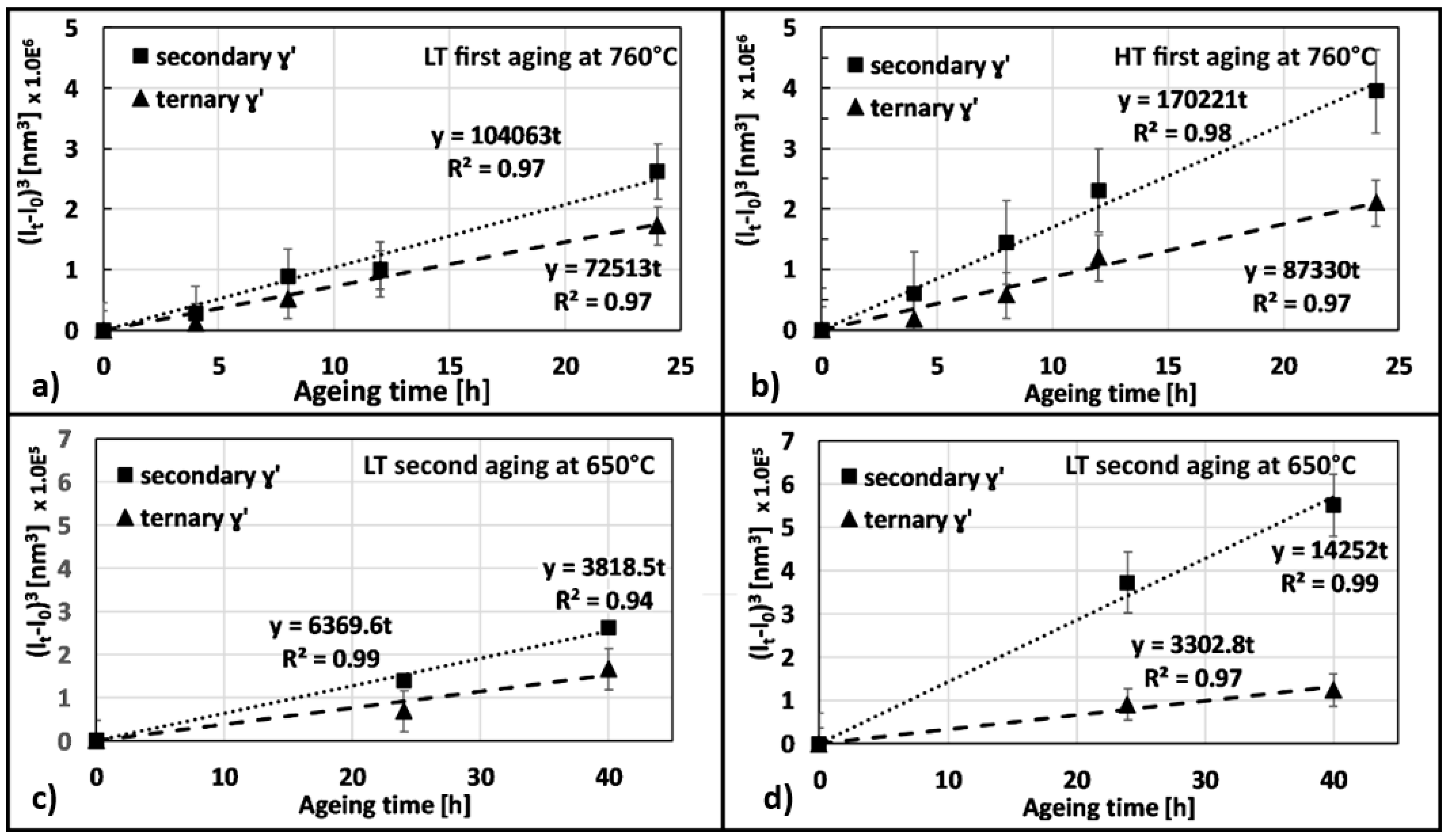
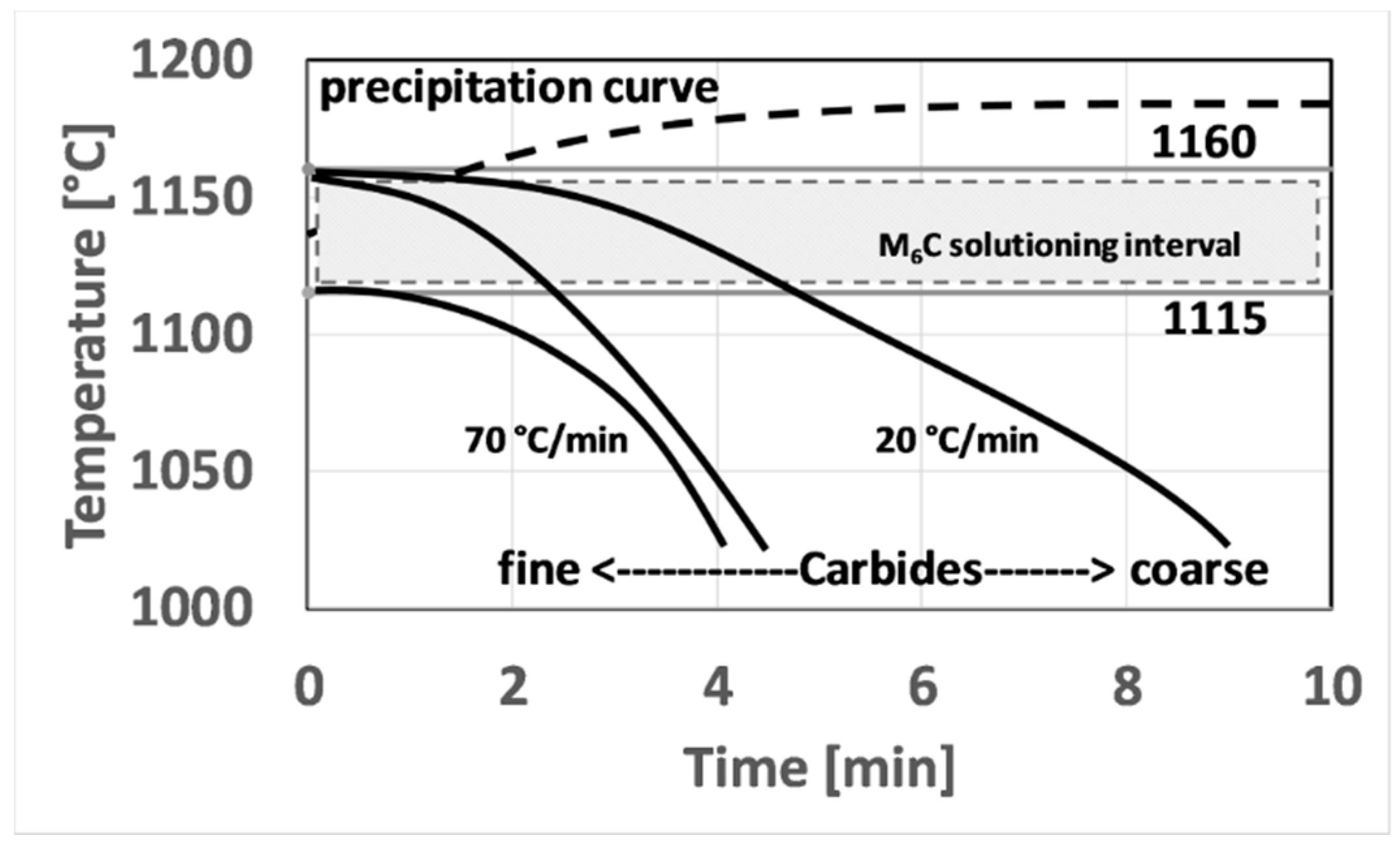
| Element | Ni | Co | Cr | Mo | Al | Ti | Fe | Zr | N | C | S | O |
|---|---|---|---|---|---|---|---|---|---|---|---|---|
| w% | bal | 17.8 | 14.3 | 5.62 | 4.6 | 3.68 | 0.18 | 0.05 | 0.004 | 0.014 | <0.002 | 0.01 |
| Sample Name | Solutioning Temperature [°C] | Cooling Rate after Solutioning [°C/min] | γ′ Fraction [% vol] |
|---|---|---|---|
| LT | 1115 | 70 | 44 |
| HT | 1160 | 70 | 35 |
| Condition | Fraction of Area [%] | Average Diameter [nm] |
|---|---|---|
| Solutioned | 0.35 | 630 ± 45 |
| First ageing | 0.37 | 637 ± 61 |
| Second ageing | 0.40 | 659 ± 53 |
| Condition | Fraction of Area [%] | Average Diameter [nm] |
|---|---|---|
| Solutioned | 0.23 | 321 ± 82 |
| First ageing | 0.30 | 530 ± 53 |
| Second ageing | 0.35 | 580 ± 78 |
© 2019 by the authors. Licensee MDPI, Basel, Switzerland. This article is an open access article distributed under the terms and conditions of the Creative Commons Attribution (CC BY) license (http://creativecommons.org/licenses/by/4.0/).
Share and Cite
Bassini, E.; Cattano, G.; Marchese, G.; Biamino, S.; Ugues, D.; Lombardi, M.; Vallillo, G.; Picqué, B. Study of the Effects of Aging Treatment on Astroloy Processed via Hot Isostatic Pressing. Materials 2019, 12, 1517. https://doi.org/10.3390/ma12091517
Bassini E, Cattano G, Marchese G, Biamino S, Ugues D, Lombardi M, Vallillo G, Picqué B. Study of the Effects of Aging Treatment on Astroloy Processed via Hot Isostatic Pressing. Materials. 2019; 12(9):1517. https://doi.org/10.3390/ma12091517
Chicago/Turabian StyleBassini, Emilio, Giulio Cattano, Giulio Marchese, Sara Biamino, Daniele Ugues, Mariangela Lombardi, Gianfranco Vallillo, and Benjamin Picqué. 2019. "Study of the Effects of Aging Treatment on Astroloy Processed via Hot Isostatic Pressing" Materials 12, no. 9: 1517. https://doi.org/10.3390/ma12091517
APA StyleBassini, E., Cattano, G., Marchese, G., Biamino, S., Ugues, D., Lombardi, M., Vallillo, G., & Picqué, B. (2019). Study of the Effects of Aging Treatment on Astroloy Processed via Hot Isostatic Pressing. Materials, 12(9), 1517. https://doi.org/10.3390/ma12091517









